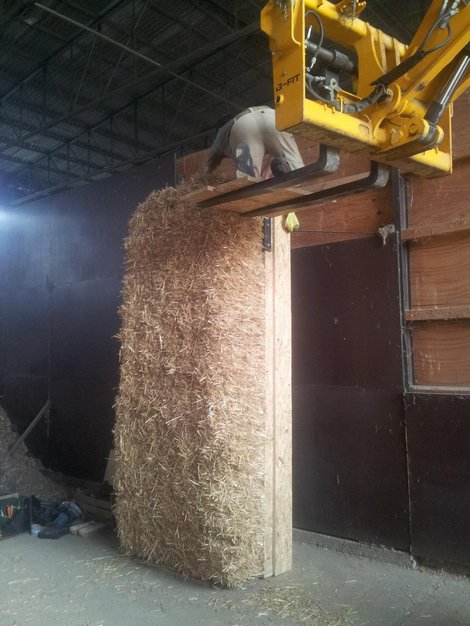Smart Straw
A start-up is developing a system to simplify the construction of straw bale houses

The bioeconomy is becoming part of everyday life and work in Saxony-Anhalt. During this period of structural change, Saxony-Anhalt is transforming itself into a model region. Alongside expertise, experience and established companies, there is one other important factor: the courage to turn visions into reality and to encourage the growing interest in biobased, sustainable products. Werner Ehrich is one of the people who takes sustainability seriously and exploits the full potential of ideas. Ehrich comes from the town of Weißenfels in Saxony-Anhalt and is founding a company that aims to simplify the construction of straw bale houses.
The basic concept is by no means new. More than 130 years ago, migrant workers in Nebraska used straw bales like bricks to build the walls of houses because of a lack of wood. The oldest straw bale house in Europe can be found in France and dates back over 100 years. A building method that had been long forgotten is enjoying a renaissance. According to Germany’s association for straw bale construction, the Fachverband Strohballenbau Deutschland e. V., there are around 400 straw bale houses in the country and this figure is growing. Werner Ehrich has a number of answers to the question “Why?”: “Straw is a natural, renewable raw material which provides excellent insulation and almost no energy is used to produce it.” This gives it a smaller carbon footprint than any conventional building material. Straw combined with wood fixes carbon dioxide and can help to protect the climate. One tonne of straw traps 1.5 tonnes of CO2. That is equivalent to the CO2 emissions of a medium-sized car traveling around 7000 kilometers. But building a house with straw bales is not that simple. And this is where Werner Ehrich’s idea comes in. Traditionally, small straw bales have been used to renovate buildings or construct new ones. They are pushed into a supporting structure and then compressed. After this they are plastered or boarded in. A constant watch has to be kept on the sky, because rain can harm the straw.
Werner Ehrich, who has been the owner of an environmental architectural practice for more than 25 years, has been involved with straw bale buildings for over 15 years and has extensive experience of renovating old buildings. As a carpenter and qualified architect, he can make an expert assessment of structures that need renovation and new-build projects. He is familiar with the market and understands the possibilities for using assembly systems. He realized: “We can do this better.” He noticed the large straw bales in the region’s arable fields and thought: “They’re ideal. We need to use them.”
No binders or additives
He believes that “everything in nature functions in self-stabilizing closed loops,” and so on his drawing board he designed a frame system, which is a large component to hold the large straw bales. This has a number of useful attributes. It gives an accurate fit, compresses the straw, provides significant heat insulation and is load-bearing and easily dismantled. It is made of wood and, of course, straw. No binders or additives are needed and hardly any energy is used in the construction process. The “straw with a frame” has now been patented and has attracted considerable attention. One interested party is a young structural engineer with creative talents from Halle (Saale) who is in the process of completing his master's dissertation in engineering. During a meeting of the “Bauzirkel Leipzig,” a construction association that is committed to a cradle-to-cradle approach for an integrated and consistent circular economy, he found out from Werner Ehrich about the large construction component containing straw. Out of this encounter came the plan to found a company in Weißenfels in early 2022 with the working title of “Stroh mit Köpfchen” (smart straw).
Support from the Weinberg Campus Accelerator
The pair have been given support by the Weinberg Campus Accelerator at Weinberg Campus Technology Park in Halle (Saale), an accelerator program for start-ups in the biomedical and life sciences, greentech, bioeconomy and new materials sectors. The start-up accelerator provides the two potential founders of the company with the expertise they need to become independent, contacts with important networks and coaching sessions that give them the information they will need over the next few months. “If you have little experience of setting up a company, all of this is very important,” says Werner Ehrich, who has already taken the next steps towards founding his start-up. He has built a prototype and aroused even greater interest among potential customers. In the fall, the first show house will be built in Weißenfels. The plan is for the start-up to go into pre-production in a factory building so that the work can done quickly regardless of the weather. Now Ehrich is looking for a method of compressing the straw and moving the components. One frame weighs around 200 kilograms and is 2.5 to 3.5 meters high and 1.25 meters wide. “It would be great if we could find some financial support for this,” he says. At the moment, the straw is still being compressed by hand in his yard. It is supplied by an agricultural cooperative in nearby Bad Dürrenberg. “One of the advantages is that straw is an agricultural waste product and so is available almost everywhere,” says Ehrich. He is also convinced that the straw component “is the best method for building houses” and structures of any kind from offices and public buildings, such as child day-care centers, to commercial properties.
“The future is under our feet.”
The fact that the system works has been demonstrated not only by the farmworkers in Nebraska. Straw bale houses have been built with the help of Werner Ehrich in Leipzig-Lindenau. In Großjena near Naumburg, a straw bale chalet made of wood, lime and straw with a historic vaulted cellar is being planned. Another example in Saxony-Anhalt is the three-story apartment building in the Sieben Linden ecovillage in Beetzendorf in the Altmark region. Werner Ehrich helped to build the first straw bale house here. He also mentions historic buildings that he describes as “early eco-houses,” because they are built from wood, straw and lime which makes them “easy to dismantle almost completely.” Most of them have stood for many years, because contrary to popular opinion, buildings insulated with lime and straw last for a very long time.
What was not available to the builders back then was the large-scale construction method which the new start-up from Saxony-Anhalt plans to deliver soon. “In principle we are supplying giant straw bricks,” says Ehrich. The strength of the components can be adjusted and they are the height of a room and easy to assemble. In addition, they do not need a supporting structure. Werner Ehrich explains that one thing is very important to him. He is repeatedly asked about this: “The straw does not attract mice. They only go where they can find the remains of the grain, but the efficiency of the latest generation of combine harvesters means that there is no grain left.” According to Werner Ehrich, his straw and wood system has “only benefits.” He says: “Building sustainably means protecting the climate as you go. The future is under our feet, along with the straw.”
Author: Manuela Bock/IMG Sachsen-Anhalt

As a long standing location for the nutrition, chemicals, wood/cellulose and agricultural economy,
we have excellent knowledge of renewable resources and biotechnology processes as the basis for industry, energy and nutrition.
